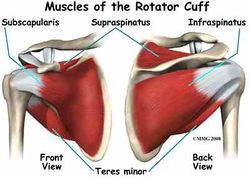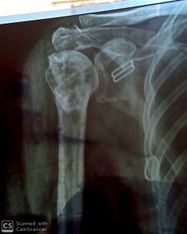Dynamic Stabilisers of the Shoulder Complex: Difference between revisions
No edit summary |
No edit summary |
||
| Line 11: | Line 11: | ||
line of action of three parts of deltoid follows line of pull of middle deltoid | line of action of three parts of deltoid follows line of pull of middle deltoid | ||
the resultant (Fd) resolved into a very large translatory component (Fx) and a small rotatory component (Fy).<ref name=":0">Levangie PK, Norkin CC. Joint Structure and Function; A Comprehensive Analysis. 5th. Philadelphia: Fadavis Company. 2012.</ref> | the resultant (Fd) resolved into a very large translatory component (Fx) and a small rotatory component (Fy).<ref name=":0">Levangie PK, Norkin CC. Joint Structure and Function; A Comprehensive Analysis. 5th. Philadelphia: Fadavis Company. 2012.</ref> | ||
| | |174x174px]] | ||
Deltoid has a significant role as a stabilizer and generally accepted as a prime mover for glenohumeral abduction along with supraspinatus. | Deltoid has a significant role as a stabilizer and generally accepted as a prime mover for glenohumeral abduction along with supraspinatus. | ||
| Line 19: | Line 19: | ||
Rotator cuff not only abduct the shoulder it play a role as a stabilizer muscles<ref>Escamilla RF, Yamashiro K, Paulos L, Andrews JR. [https://www.ncbi.nlm.nih.gov/pubmed/19769415 Shoulder muscle activity and function in common shoulder rehabilitation exercises. Sports medicine.] 2009 Aug 1;39(8):663-85.</ref> | Rotator cuff not only abduct the shoulder it play a role as a stabilizer muscles<ref>Escamilla RF, Yamashiro K, Paulos L, Andrews JR. [https://www.ncbi.nlm.nih.gov/pubmed/19769415 Shoulder muscle activity and function in common shoulder rehabilitation exercises. Sports medicine.] 2009 Aug 1;39(8):663-85.</ref> | ||
From figure 2 we can see all three muscles (teres minor,subscapularis,infraspinatus) in relation to their anatomical position and their muscle fiber direction from origin to insertion, tend to have similar inferior line of pull<ref name=":0" /> and with the summation of three forces of rotator cuff they nearly offset superior translation of humeral head created by deltoid. The wide range of motion of the shoulder is allowed by the variety of rotational moments of the cuff muscles<ref>Longo UG, Berton A, Papapietro N, Maffulli N, Denaro V. [https://www.ncbi.nlm.nih.gov/pubmed/?term=Biomechanics+of+the+rotator+cuff%3A+European+perspective.+InRotator+Cuff+Tea Biomechanics of the rotator cuff: European perspective. InRotator Cuff Tea]r 2012 (Vol. 57, pp. 10-17). Karger Publishers.</ref>. Teres minor ,Infraspinatus as they are external rotators they contribute in abduction of arm by external rotation that participate clearing greater tubercle underneath the acromion. | From figure 2 we can see all three muscles (teres minor,subscapularis,infraspinatus) in relation to their anatomical position and their muscle fiber direction from origin to insertion, tend to have similar inferior line of pull<ref name=":0" /> and with the summation of three forces of rotator cuff they nearly offset superior translation of humeral head created by deltoid. The wide range of motion of the shoulder is allowed by the variety of rotational moments of the cuff muscles<ref>Longo UG, Berton A, Papapietro N, Maffulli N, Denaro V. [https://www.ncbi.nlm.nih.gov/pubmed/?term=Biomechanics+of+the+rotator+cuff%3A+European+perspective.+InRotator+Cuff+Tea Biomechanics of the rotator cuff: European perspective. InRotator Cuff Tea]r 2012 (Vol. 57, pp. 10-17). Karger Publishers.</ref>. Teres minor ,Infraspinatus as they are external rotators they contribute in abduction of arm by external rotation that participate clearing greater tubercle underneath the acromion. [[File:Muscles Rotator Cuff.jpg|thumb|figure 2|249x249px]] | ||
=== '''Supraspinatus and glenohumeral stabilization''' === | === '''Supraspinatus and glenohumeral stabilization''' === | ||
Regarding to supraspinatus location more superior than the three other rotator cuff it has a line of pull superior that can't offset deltoid force. | Regarding to supraspinatus location more superior than the three other rotator cuff it has a line of pull superior that can't offset deltoid force. | ||
| Line 25: | Line 25: | ||
Even though it still an effective stabilizer due to it's larger moment arm ,it's capable to elevate glenohumeral joint near normal.<ref name=":0" /> | Even though it still an effective stabilizer due to it's larger moment arm ,it's capable to elevate glenohumeral joint near normal.<ref name=":0" /> | ||
From illustrated above we can consider deltoid and rotator cuff as one of a force couple of glenohumeral joint. | From illustrated above we can consider deltoid and rotator cuff as one of a force couple of glenohumeral joint. | ||
Imbalance of one or more of these muscle consider a contribution cause to shoulder problems ([[Rotator Cuff Tendinopathy|impingement]] , [[Shoulder Bursitis|bursitis]] , instability ) | |||
=== Conclusion === | === Conclusion === | ||
For smooth synchronous movement of shoulder we need deltoid and rotator cuff muscles to work in proper timing and adequate forces to offset each other.As deltoid act to stabilize humeral head against glenoid cavity with small participation to abduct the arm, there are(subscapularis, teres minor, infraspinatus) their force of pull balance deltoid action along with supraspinatus that participate mainly in arm abduction. | [[File:Humeral head.jpeg|thumb|234x234px|figure 3]]For smooth synchronous movement of shoulder we need deltoid and rotator cuff muscles to work in proper timing and adequate forces to offset each other.As deltoid act to stabilize humeral head against glenoid cavity with small participation to abduct the arm, there are(subscapularis, teres minor, infraspinatus) their force of pull balance deltoid action along with supraspinatus that participate mainly in arm abduction. | ||
Deficit in one of these forces for example;insufficient activation of rotator cuff /deltoid over activation participate to narrowing coracoacomial space (figure 3) that compress tendons in this space<ref><article> | Deficit in one of these forces for example;insufficient activation of rotator cuff /deltoid over activation participate to narrowing coracoacomial space (figure 3) that compress tendons in this space<ref><article> | ||
[https://www.physiospot.com/research/rotator-cuff-coactivation-ratios-in-participants-with-subacromial-impingement-syndrome-2/ Joseph B. Myers, Ji-Hye Hwang, Maria R. Pasquale, J. Troy Blackburn and Scott M. Lephart. Rotator cuff coactivation ratios in participants with subacromial impingement syndrome. Journal of Science and Medicine in Sport, Volume 12, Issue 6, November 2009, Pages 603-608] | [https://www.physiospot.com/research/rotator-cuff-coactivation-ratios-in-participants-with-subacromial-impingement-syndrome-2/ Joseph B. Myers, Ji-Hye Hwang, Maria R. Pasquale, J. Troy Blackburn and Scott M. Lephart. Rotator cuff coactivation ratios in participants with subacromial impingement syndrome. Journal of Science and Medicine in Sport, Volume 12, Issue 6, November 2009, Pages 603-608] | ||
</article></ref> | </article></ref> | ||
== Related article == | == Related article == | ||
Revision as of 00:35, 14 February 2020
Original Editor - Your name will be added here if you created the original content for this page.
Top Contributors - Khloud Shreif, Amanda Ager, Kim Jackson and Rishika Babburu
Introduction[edit | edit source]
Glenohumeral joint relies on static and dynamic contributions to maintain joint stability,static stability include joint labrum and associated capsuloligamentous components .Dynamic stabilizers refer to rotator cuff (supraspinatus, infraspinatus, subscapularis ,teres minor) and periscapular muscles[1].Dynamic stabilizers are important to work synergistically for proper movement and to avoid impingement of shoulder.
Deltoid and glenohumeral stabilization[edit | edit source]

Deltoid has a significant role as a stabilizer and generally accepted as a prime mover for glenohumeral abduction along with supraspinatus.
From the figure that show the line of action of deltoid with arm at side , the parallel force component (fx)directed superior is larger of three other component so that , the majority of deltoid contraction causes humeral head translate superior and a small applied perpendicular force is directed to rotate humerus . That we need an inferior pull force to offset the (fx) component of middle deltoid for active arm elevation as gravity force can't balance this force.[3]
Rotator cuff and glenohumeral stabilization[edit | edit source]
Rotator cuff not only abduct the shoulder it play a role as a stabilizer muscles[4]
From figure 2 we can see all three muscles (teres minor,subscapularis,infraspinatus) in relation to their anatomical position and their muscle fiber direction from origin to insertion, tend to have similar inferior line of pull[2] and with the summation of three forces of rotator cuff they nearly offset superior translation of humeral head created by deltoid. The wide range of motion of the shoulder is allowed by the variety of rotational moments of the cuff muscles[5]. Teres minor ,Infraspinatus as they are external rotators they contribute in abduction of arm by external rotation that participate clearing greater tubercle underneath the acromion.
Supraspinatus and glenohumeral stabilization[edit | edit source]
Regarding to supraspinatus location more superior than the three other rotator cuff it has a line of pull superior that can't offset deltoid force.
Even though it still an effective stabilizer due to it's larger moment arm ,it's capable to elevate glenohumeral joint near normal.[2]
From illustrated above we can consider deltoid and rotator cuff as one of a force couple of glenohumeral joint.
Imbalance of one or more of these muscle consider a contribution cause to shoulder problems (impingement , bursitis , instability )
Conclusion[edit | edit source]
For smooth synchronous movement of shoulder we need deltoid and rotator cuff muscles to work in proper timing and adequate forces to offset each other.As deltoid act to stabilize humeral head against glenoid cavity with small participation to abduct the arm, there are(subscapularis, teres minor, infraspinatus) their force of pull balance deltoid action along with supraspinatus that participate mainly in arm abduction.
Deficit in one of these forces for example;insufficient activation of rotator cuff /deltoid over activation participate to narrowing coracoacomial space (figure 3) that compress tendons in this space[6]
Related article[edit | edit source]
anatomy and biomechanics/biomechanics of shoulder movement/static structure and mechanoreceptors
shoulder musculature
What kind of exercises can be used /select exercises for rotator cuff strengthening
- Stability and instability of the glenohumeral joint: the role of shoulder muscles[7]
References[edit | edit source]
- ↑ Curl LA, Warren RF. Glenohumeral joint stability: selective cutting studies on the static capsular restraints. Clinical Orthopaedics and Related Research®. 1996 Sep 1;330:54-65.
- ↑ 2.0 2.1 2.2 Levangie PK, Norkin CC. Joint Structure and Function; A Comprehensive Analysis. 5th. Philadelphia: Fadavis Company. 2012.
- ↑ Levangie PK, Norkin CC. Joint Structure and Function; A Comprehensive Analysis. 5th. Philadelphia: Fadavis Company. 2012.
- ↑ Escamilla RF, Yamashiro K, Paulos L, Andrews JR. Shoulder muscle activity and function in common shoulder rehabilitation exercises. Sports medicine. 2009 Aug 1;39(8):663-85.
- ↑ Longo UG, Berton A, Papapietro N, Maffulli N, Denaro V. Biomechanics of the rotator cuff: European perspective. InRotator Cuff Tear 2012 (Vol. 57, pp. 10-17). Karger Publishers.
- ↑ <article> Joseph B. Myers, Ji-Hye Hwang, Maria R. Pasquale, J. Troy Blackburn and Scott M. Lephart. Rotator cuff coactivation ratios in participants with subacromial impingement syndrome. Journal of Science and Medicine in Sport, Volume 12, Issue 6, November 2009, Pages 603-608 </article>
- ↑ Labriola JE, Lee TQ, Debski RE, McMahon PJ. Stability and instability of the glenohumeral joint: the role of shoulder muscles. Journal of shoulder and elbow surgery. 2005 Jan 1;14(1):S32-8.








